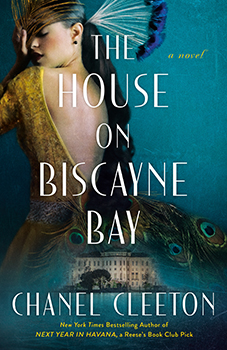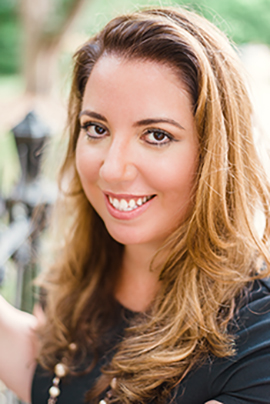

Features Chanel Cleeton
Strong Women, a Creepy Mansion, and a Tribute to Miami
The Big Thrill Interviews New York Times Bestselling Author Chanel Cleeton
By Susan Goldenberg
 THE HOUSE ON BISCAYNE BAY, publishing in April by Berkley/Penguin Random House, marks several milestones for Miami-based New York Times and USA Today bestselling author Chanel Cleeton. It’s her 18th published book (the first was in 2014) and her first Gothic.
THE HOUSE ON BISCAYNE BAY, publishing in April by Berkley/Penguin Random House, marks several milestones for Miami-based New York Times and USA Today bestselling author Chanel Cleeton. It’s her 18th published book (the first was in 2014) and her first Gothic.
Biscayne Bay is on Florida’s east side at Miami. “I chose southern Florida because it has so much history, including some grandiose mansions from the early 1900s,” Chanel explained to me in a Zoom conversation, citing examples like “Whitehall,” built 1900-1901 by industrialist Henry Flagler, a major figure in Florida’s development, and “Vizcaya,” built in 1914-1922 by businessman James Deering of Deering-International Harvester. They are now tourist sites.
Chanel gave her fictional house the beguiling name “Marbrisa” (Spanish for “Sea Breeze”) to “transport readers into the spirit of the place and show the Spanish influence on Florida.” On the first page, she writes: “The house looms before me, a pale stone behemoth jettisoning from the swampy earth. It casts a long shadow, towering three stories high with a parapet on top as though it’s readying itself to guard against intruders. Its palatial size and exterior appear to have been plucked from some European city.” Right away, a reader knows that mystery, suspense, intrigue, and danger are coming. There’s also a maze that’s important to the plot.
Marbrisa has 61 rooms. “Why not a rounded-out 60?” I asked. Chanel smiled. “It’s a way of showing the eccentricity of such homes—and those who built them.”
I then asked, “Why do you think Gothic novels are perennially popular?” She replied: “I love Gothic novels. You are wholly immersed in the setting. Reading late at night in bed, you’re transported. There’s so much action and suspense.”
The book has two timelines, in both of which the house is pivotal. The first is the early years of south Florida’s development when Anna Barnes moves down to Miami from New York City with her husband, Robert. The second is 20 years later, as the U.S. is on the brink of entering the Second World War. The protagonist is Carmen Acosta. Chanel has three timelines in the book she’s now writing. “I love multiple timelines; they broaden understanding and suspense.”
Anna and Carmen are unalike in appearance and personality and alike in possessing great inner strength. Chanel likes to have “strong women” in her books. She uses first person “I” for both women, including what they’re thinking—often amusingly opposite from what they’re saying. “I love working with first-person access to characters so readers can see what’s going on in their head. It gives readers intimacy, a connection to the characters, a way to know and understand them, root for them.
“I express their feelings, complexities, dynamics, and motivations to make them real to readers.”
Conventionally, authors dedicate books to a person(s). Chanel’s dedication in THE HOUSE ON BISCAYNE BAY is: “To Miami…for everything.” Her reason? “I wanted to show what influenced the book. Miami welcomed my Cuban refugee family when they came in 1967. (Chanel was born subsequently.) I feel very at home here. It’s a special place, and I wanted to honor that.” Chanel previously published a five-novel series about a Cuban family, inspired by her own Cuban-American heritage. The first, Next Year in Havana (2018), was a Reese’s Book Club Pick, operated by movie actress-producer Reese Witherspoon.
THE HOUSE ON BISCAYNE BAY’s final scene is on a road from Marbrisa. There’s a memorable last sentence: “An alligator slithers by.” “Have you ever encountered an alligator crossing a road?” I asked Chanel. “No, but it happens,” she said, “and there’ve been instances when they’ve appeared at people’s swimming pools.”
Chanel finds Scrivener helpful and color codes to make it easy to shift what scenes she wants. “I write everywhere—my desktop computer, portable Freewrite, phone, coffee shop. My advice is to always have something on which you can jot down a thought.”
At the end of her books, she includes a questionnaire she composed for suggested use in readers’ book group discussions. In this book, for example, she asks, “Which heroine did you identify with more—Anna or Carmen? What characteristics in their personalities did you relate to? What differences? How do they grow and change throughout the novel?” Another example: “How does the novel’s setting influence the book?” She composes the quiz after finishing the manuscript.
Chanel’s initial writing genre was romance. “It gave me experience in building characters and emotional connections, in how to write dialogue and banter—there tends to be lots in romance books—and to be disciplined so as to meet publishing schedules.” She has degrees in global politics, international relations, and law. After graduating from law school, she embarked on writing and has never had a law practice. But she says her legal studies have been helpful in that they enhanced her analytical skills.
Her advice for aspiring authors: “You have to have passion for writing. Rejection happens. It happened to me. It’s a disheartening part of the business we all experience. You have to have perseverance and push through.”
Chanel relaxes by reading. “I’m a big reader; I love reading.” Three of her all-time favorite books: The Map of Love by Ahdaf Soueif, The Historian by Elizabeth Kostova, and Waiting for Snow in Havana by Carlos Eire.
The Big Thrill Interviews New York Times Bestselling Author Chanel Cleeton
- Graham Moore - May 23, 2024
- Susan Elia MacNeal - May 23, 2024
- Chanel Cleeton - April 25, 2024

